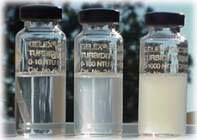
Photo from wikipedia
Concentrations and fluxes of total and methylmercury were determined in surface sediments and associated with settling particles at two sites in Lake Geneva to evaluate the sources and dynamics of… Click to show full abstract
Concentrations and fluxes of total and methylmercury were determined in surface sediments and associated with settling particles at two sites in Lake Geneva to evaluate the sources and dynamics of this toxic contaminant. Total mercury concentrations measured in settling particles were different throughout the seasons and were greatly influenced by the Rhone River particulate inputs. Total mercury concentrations closer to shore (NG2) ranged between 0.073 ± 0.001 and 0.27 ± 0.01 μg/g, and between 0.038 ± 0.001 and 0.214 ± 0.008 μg/g at a site deeper in the lake (NG3). Total mercury fluxes ranged between 0.144 ± 0.002 and 3.0 ± 0.1 μg/m2/day at NG2, and between 0.102 ± 0.008 and 1.32 ± 0.08 μg/m2/day at NG3. Combined results of concentrations and fluxes showed that total mercury concentrations in settling particles are related to the season and particle inputs from the Rhone River. Despite an observed decrease in total mercury fluxes from the coastal zone towards the open lake, NG3 (~ 3 km from the shoreline) was still affected by the coastal boundary, as compared to distal sites at the center of the lake. Thus, sediment focusing is not efficient enough to redistribute contaminant inputs originating from the coastal zones, to the lake center. Methylmercury concentrations in settling particles largely exceeded the concentrations found in sediments, and their fluxes did not show significant differences with relation to the distance from shore. The methylmercury found associated with settling particles would be related to the lake’s internal production rather than the effect of transport from sediment resuspension.
Journal Title: Environmental Science and Pollution Research
Year Published: 2018
Link to full text (if available)
Share on Social Media: Sign Up to like & get
recommendations!